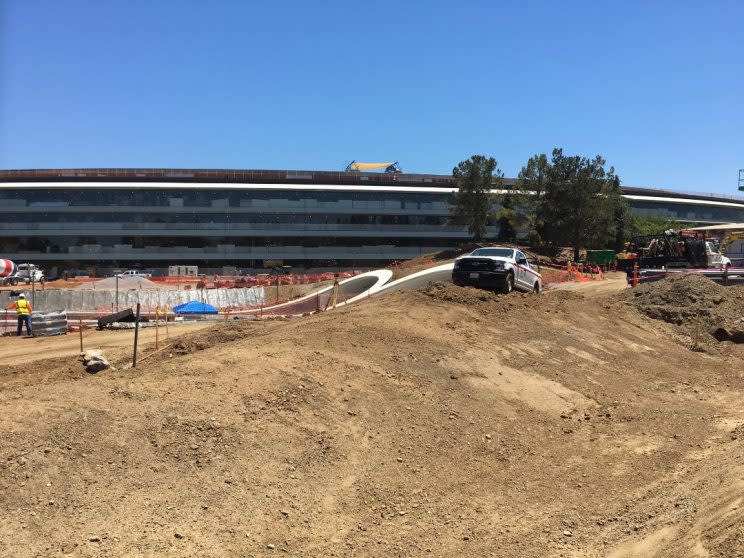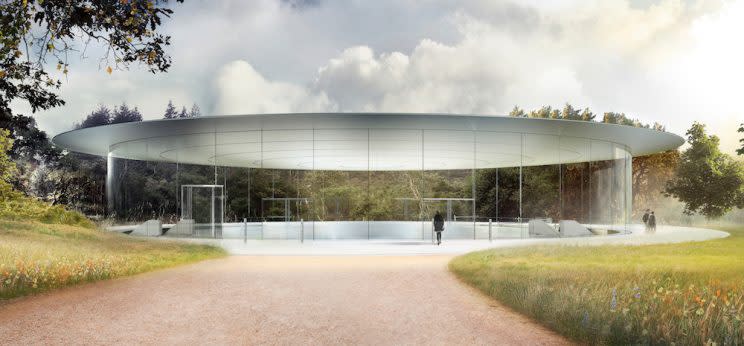Here's what we know about Apple's glistening new $5 billion campus
Security for Apple’s new Cupertino, Calif., headquarters is just as tight as the secrecy it wields over its popular products and services. Take it from me.
A visit last week to Apple Park resulted in yours truly getting booted five minutes after wandering down the campus’s entry street, appropriately called, “Apple Pkwy (Private).” But what I glimpsed of Apple’s (AAPL) new $5 billion campus was nonetheless an impressive sight.
Located 45 miles outside San Francisco, the 175-acre Apple Park is largely surrounded by residential homes and small shopping plazas serving up Starbucks (SBUX) coffee.

Mounds of tossed-up dirt and construction vehicles surround Apple Park’s main building — a 2.8-million-square-foot, ring-shaped, “spaceship”-like structure that runs entirely on sustainable energy, mostly drawn from 805,000 square feet of solar arrays, according to Apple. Sunlight gleamed off its curved glass walls, many of which were covered up — either because they were just that new, for privacy reasons, or both.

Employees started moving into Apple Park this April and will continue to do so throughout the year. When all 12,000 or so employees eventually relocate there, it will mark the completion of one of the boldest commercial offices project ever in Silicon Valley’s history.
Designed in collaboration with London-based architecture firm Foster + Partners, whose founder and chairman Norman Foster designed the Hong Kong airport, the Apple Park is an architectural marvel — a project kickstarted about 13 years ago by former Apple CEO Steve Jobs and Chief Design Officer Jonathan, or “Jony,” Ive as a way to consolidate Apple employees.
Apple, which is notorious for taking painstaking care with every step of development of its hardware, was just as meticulous with developing Apple Park, down to the drought-resistant 9,000 or so trees planted on campus and the ring-shaped structure, sheathed entirely in curved glass.
Apple Park’s cafeteria sports four-story tall glass doors on the exterior that quietly slide open and closed thanks to an underground mechanical system. Meanwhile, the 100,000-square-foot fitness and wellness center, which includes access to medical and dental services, offers a two-story yoga room covered in stone, finished to closely resemble the same stone at Jobs’ favorite hotel in Yosemite. And resting on a hill yards away, the Steve Jobs theater is a 20-foot-tall glass cylinder covered by a carbon-fiber roof that seats up to 1,000 people.

Surrounding parklands, an orchard, meadow and pond will also offer two miles or so of walking and running paths for employees.
One of the few amenities Apple Park is conspicuously missing is on-site child day care — a design move Apple has been criticized for.
According to a Wired magazine story in May, the tech giant went to extraordinary lengths to recreate Steve Jobs’ original vision, which included making Apple Park “as white” as possible. That meant having Ive work with his design team to develop a way to offset the green tint typically found in glass. The solution? Painting the backs of 800 custom-made glass panels white and affixing them to perforated sheets of metal coated on one side with white silicon and a touch of pink.
Jobs also had another wish for Apple Park: build a structure that “breathes just like the people who work inside it.” The engineering team consulted with experts who optimize airflow in Formula One race cars to build a ventilation system that “inhales” air through the bottom of glass canopies that provide shade for each floor and “exhales” air through shafts sprinkled throughout the building.
Several intrepid folks have glimpsed much more by flying aerial drones over Apple Park and capturing some remarkable footage:
“I revere him [Jobs],” Cook told Wired. “And this was clearly his vision, his concept. Our biggest project ever.”
Would Jobs, a stickler for even the smallest of details, be satisfied with the final product? While it’s impossible to know for sure, what’s obvious with Apple Park is that Jobs’ ethos for design perfection most certainly remains in the DNA of the company — and now the campus — he helped build and left behind.
—
JP Mangalindan is a senior correspondent for Yahoo Finance covering the intersection of tech and business. Email story tips and musings to [email protected]. Follow him on Twitter or Facebook.
More from JP:
